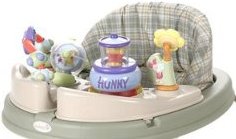Many parents incur significant expenses during the year to care for their children. The IRS recognizes this and provides tax benefits for families with children. In addition to claiming an exemption for each child that qualifies as a dependent, there are a couple of tax credits that can help families reduce their tax bill.
 The child and dependent care credit
The child and dependent care credit
For the 2013 tax year, the child and dependent care credit can be applied when a taxpayer pays someone to care for their children that are under the age of 13. Specifically, families can apply up to $3,000 of qualified expenses and $6,000 for two or more children to the credit. However, there are certain restrictions. Depending on your income, the tax credit that can be applied to your tax bill ranges from 20% to 35% of the qualified expenses. Thus, the minimum tax credit to be claimed would be $600 for one child and up to $2,100 for two children. Families with tax income that exceeds $43,000 are limited to a tax credit equivalent to 20% of qualified expenses or $600 for one child and $1,200 for two or more. The other restriction to note is that both parents must have earned income (employment income, not investment income) or one is a full-time student to claim the credit. The credit is based on the spouse with the least amount of income. This means that if you work and earn $120,000, but your spouse doesn’t earn any income and is not a full-time student, you will not be eligible for the tax child and dependent care tax credit.
What Expenses Count?
Generally eligible expenses include day-care, before and after school programs, nanny care and babysitting, but not if your teenage daughter is the sitter. Sending your child to a private elementary school also does not count as that is considered an educational expense.
Don’t overlook a flexible spending account
Parents with a child-care flexible spending account (FSA) may benefit more from using that money for child-care expenses than using out-of-pocket dollars to be eligible for the tax credit. The FSA allows parents to use pre-tax dollars (before income taxes and Social Security/Medicare expenses are deducted) to pay for child-care expenses. For instance, taxpayers in the 28% tax bracket would avoid paying 28% plus Social Security/Medicare 7.65% or 35.65% in taxes. If you set aside the maximum $5,000 of your FSA to child-care expenses, you would be saving $1,783 in taxes. You would be saving less or $1,000 (20% of $5,000) if you claimed that tax credit and earn income above $43,000. So, it depends on the situation but the FSA could be a better option.
What about the child tax credit?
Many families may be eligible for the child tax credit of $1,000 per qualifying child under the age of 17 at the end of 2013. In order to claim the credit, they must be claimed as a dependent on your tax return. In addition, like the child and dependent care credit, there are restrictions based on income. Specifically, the credit that can be claimed is reduced when your taxable income is $110,000 or more for joint filers and $75,000 for single or head of household filers. If your income exceeds these levels, the child tax credit is reduced by $50 for each $1,000 of income above these threshold amounts.
More Tax Questions? Ask child tax credit questions online.
Related Articles
->Are There Any Tax Breaks For Summer Day Camp?
->Are You Prepared For A Higher Tax Bill?
->Should You Always File Jointly?
->Are You Overlooking These 2013 Tax Deductions?
->Should You Setup a Custodial Account For Your Child?
->Can I Setup a Low Minimum Roth IRA For My Child?
->Should Parents Add Their Adult Children To Their Health Care Plan?


